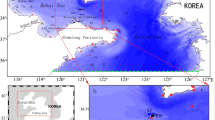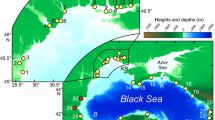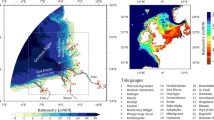Abstract
In this study an analytical tide model of uniform width with three sub-regions is presented. The three-subregions model takes into account step-like variations in depths in the direction of the channel as a way to examine the M2 tide of the East China Sea (ECS) as well as the Yellow Sea (YS). A modified Proudman radiation condition has been applied at the northern open head, while the sea surface elevation is specified at the southern open boundary. It is seen that, due to the presence of an abrupt change in depth, co-amplitude lines of the M2 tide are splitted to the east and west near the end of the ECS shelf region. Variations in depths, bottom friction and the open head boundary conditions all contribute to the determination of formation of amphidromes as well as overall patterns of M2 tidal distribution. It is seen that increasing water depth and bottom friction in the ECS shelf results in the westward shift of the southern amphidrome. There is however no hint at all of the well-known degenerated tidal pattern being formed. It is inferred that a lateral variation of water depth has to be somehow incorporated to represent the tidal patterns in ECS in a realistic manner. Regarding the radiation factor introduced by Fang et al. (1991), use of a value larger than one, possibly with a phase shift, appears to be a proper way of incorporating the reflected waves from the northern Yellow Sea (NYS). Key words - analytical model, M2 tide, Kelvin wave, Yellow Sea, East China Sea
Similar content being viewed by others
References
Blumberg, A. and L. Kantha. 1985. Initial transients in long wave computations.J. Hydraul. Eng.,111 (2), 237–255.
Brown, T. 1987. Kelvin wave reflection at the oscillating boundary with applications to the North Sea.Cont. Shelf Res.,7(4), 351–365.
Choi, B.H. 1980. A tidal model of the Yellow Sea and the eastern China Sea. Korea Ocean Research and Development Report 80–02, 72 p.
Flather, R.A. 1976. A tidal model of the northwest European continental Shelf.Memories de la Societe Royale des Science de Liege,10, 141–164.
Fang, Z., A. Ye, and G. Fang. 1991. Solutions of tidal motions in a semi-enclosed rectangular gulf with open boundary condition specified. p. 153-168. In: Tidal hydrodynamics, ed. by B.B. Parker. John Wiley and Sons, Inc.
Godin, G. 1965. The M2 tide in the Labrador Sea, Davis Strait and Baffin Bay.Deep-Sea Res.,12, 469–477.
Kang, Y.Q. 1984. Analytical model of tidal waves in Yellow Sea.J. Mar. Res.,42, 473–485.
Kang, S.K., J.Y. Chung, Y.Q. Kang, and S.-R. Lee. 1999. An analytical model of co-oscillating tide under frictional effect in the Yellow Sea.J. Oceanogr. Soc. Kor.,34, 22–35.
Kang, S.K., S.-R. Lee, and K.D. Yum. 1991. Tidal computation of the East China Sea and the East Sea. p. 25-48. In: Oceanography of Asian marginal seas, ed. by K. Takano. Elsevier.
KORDI. 2002. Study on tidal change prediction due to the large scale of coastal reclamation (TIDPRE) (II): Tidal prediction study for coastal flooding area of Korean Peninsula. Report prepared for National Oceanographic Research Institute (NORI). 291 p.
Lee, J.C. and K.T. Jung. 1996. Computation of M2 tide for the Yellow Sea and the East China Sea using data assimilation.Ocean Res.,18, 13–24. (In Korean)
Nishida, H. 1980. Improved tidal charts for the western part of the North Pacific Ocean.Report of Hydrographic Researches,15, 55–70.
Reid, R. O. and B.R. Bodine. 1968. Numerical model for storm surges in Galvaston Bay.ASCE J. Waterways and Harbor Div.,94, 33–57.
So, J.K. 2000. Analytical and numerical model studies of the M2 tide in the Yellow Sea and the East China Sea. Ph.D. thesis, Seoul National University, Seoul. 131 p.
Taylor, G.I. 1921. Tidal oscillation in gulfs and rectangular basins.P. London Math. Soc.,2(30), 148–181.
Webb, D.J. 1976. A model of continental-shelf resonances.Deep-Sea Res.,23, 1–15.
Author information
Authors and Affiliations
Corresponding author
Rights and permissions
About this article
Cite this article
Jung, K.T., Park, C.W., Oh, I.S. et al. An analytical model with three sub-regions for m2 tide in the yellow sea and the East China Sea. Ocean Sci. J. 40, 191–200 (2005). https://doi.org/10.1007/BF03023518
Received:
Revised:
Accepted:
Issue Date:
DOI: https://doi.org/10.1007/BF03023518




